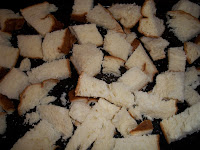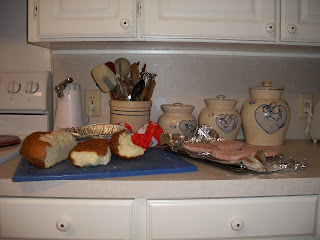One of the mainstays of United Methodist Communion is the use of those bulbous, beautiful and tasty loaves of Hawaiian Bread. They provide a identifiable and unified loaf that has become an unintentional emblem at our worship at the Table. These loaves are also large and usually have a quantity left over. So, what do we do with the leftovers?
United Methodist worship instructions say, " The consecrated elements are to be treated with reverent respect and appreciation as gifts of God’s creation that have, in the words of the Great Thanksgiving, become “for us the body and blood of Christ”" (UM Hymnal; page 10), "Although they have undergone no substantive (physical) change, the elements have been consecrated—set apart."
"If any bread and wine remain, they should always be disposed of by (1) the pastor and/or others at the pastor’s direction consuming them in a reverent manner following the service; (2) returning them to the earth by pouring (2 Samuel 23:16), burying, scattering, or burning. Also, The Book of Worship directs, “What is done with the remaining bread and wine should express our stewardship of God’s gifts and our respect for the holy purpose they have served” (Book of Worship p. 30) (see also "This Sacred Mystery", P. 31-33)
I'm going to go out on a limb here in front of God, colleagues and the cabinet and offer suggestions for our leftovers.
Waste bugs me. God has given us precious time, resources and relationships. Nothing should be wasted. If I draw some fire for having loose communion theology here, so be it but wasting the elements is not good stewardship. Here we go..........
1.) Obviously, the first priority is to serve them, or send them out with consecrated lay persons, to those in the nursing homes or home-bound. This is a touchable connection with the whole body of the church that we mustn't miss. Don't settle for wafers or disposables unless you just have to. Serving communion is the front line of disciple making of the server as well as worship for those being served..
2.) Serve large chunks to the children after the benediction. I don't just leave the leftovers out with the donuts but give them to the kids and simply say, "Jesus loves you and so do I". Some of the adults come around too. The only negative is that it cuts into my bread pudding.
3.)
Scatter them for the birds, cats and squirrels. They can also be divided among the communion stewards too. This is already the tradition of many. Our wildlife is well trained and the leftovers get cleaned up quickly. The juice accelerates de-comp in a compost bin if you are in to that also. I like the picture of the elements building muscle in animals or growth in plants but still prefer using them at home.
Here are some table uses.
Have recipes? Send them to revavanhooser@gmail.com or as a comment-
Note: Leftovers freeze. You can save them until you have enough for a recipe. We have two services and usually have enough for these uses. Obviously, any bread reaching the end of its life can freeze or be added to this.

3.)
Croutons/breadcrumbs: Cube the leftovers place them in a single layer on a baking sheet and bake them in a 200 degree oven for about 4 hours. They are done when completely dry. They don't work well for dressing-kind of slimy. If desired, lightly toss with olive oil, salt, and "Perfect Pinch" Italian herb mix. Tony's Cajun and garlic powder add a kick too. I prefer them plain.
The dried cubes can be ground in a food processor too and used for breading fish or stretching meatloaf. These are light and remind me of Panko crumbs.
4.)
Bread Pudding: The giving and receiving of bread pudding is a holy moment for me. Bread pudding was invented as a way to use bread that would otherwise be wasted. Any firm baked good can be used.
This is a generic recipe for a 9x9 glass baking dish. Double this recipe for a 9x13. It works well with Splenda, though I add 50% more than I would sugar and doubt that it helps the calorie count much.
Cube 4 cupstotal of Kings Hawaiian Bread (or leftover church donuts! Stale is good, moldy is bad) Leave them out to dry overnight if you can. The Hawaiian bread is too light for pudding without some regular bread. Add a couple of sliced of whatever you have. Stale buns are perfect. Put the cubes in a baking dish sprayed with Pam.
Prepare a custard with: 4 eggs, 2 1/4 cups milk, 1/2 cup sugar, 1 tsp. vanilla,1 tsp. cinnamon and 1/2 cups of raisins, craisins, or other dried fruit-
if desired. Whisk completely smooth but not foamy, pour on the bread and let it soak for 20 minutes or longer. Bake at 350 for 40-45 minutes. It should be firm to the touch but may jiggle a bit. You can glaze it with 1/2 cup of powdered sugar mixed with 2-3 tbsp.'s of orange juice, top it with coolwhip or just leave it alone. These are dense calories. An honest portion is probably 1/2 cup-whatever......get out the big spoon. Bread Pudding is a treat, a thing of beauty and not for everyday.
 5.) Crustini/Garlic Toast:
5.) Crustini/Garlic Toast: slice 3/4" thick, sprinkle with olive oil, parmesean cheese and "Perfect Pinch" Italian mix (Or garlic salt, Tony's or whatever suits you), toast it under a broiler until brown. Eat it with a salad or spaghetti..
6.) World's Best Cinnamon Toast. slice 3/4" thick, lightly spread with margarine, and sprinkle with mixture of 1/2 cup of sugar with 1 tsp of cinnamon. Toast the slices in a toaster first or fully prepared under a broiler until brown. Oh yeah.

7.) Sandwiches, paninis or sliders: panini-with ham, cheese and tomato. I use my George Foreman Grill for that. Toast the slices first and make sliders with "Mini-Burgers" found in the frozen foods. Bake them on a cookie sheet with minced onion on the top. Add the patty, cheese, mushrooms or whatever on the "white" side of the bread. Amp up the peanut butter and jelly with cookie cutters to make shapes for kid's lunch sandwiches.

 8.) French Toast:
8.) French Toast: Make a mixture with the proportions of 3 eggs, to One cup of milk, and 1 tsp of vanilla. This will do 1/2 of a loaf, double for a full one. Dredge full widths by 1" slices of bread into the egg mixture and cook over a medium heat in griddle or pan. I like mine with cinnamon,sugar free syrup and strong black coffee. Fruit, butter, powdered sugar, peanut butter, or Hershey's syrup works too. Whatever you are in to. This is a realistic breakfast for anyone. I had this stirred up, cooked, with dishes in the dish
washer in 20 minutes. Cut them into strips and they can go out the door in a paper napkin.
9.) Fondue-This is very hip right now. The King's bread works better with the chocolate or deep frying than the cheese. I don't have a proper fondue pot and haven't since the '70s. Those that do will have an easier time with it. Very tasty.
10.) Strata/Breakfast Casserole: Cube 4 cups the bread into a 9x13 glass baking dish that has been sprayed with non-stick spray. Mix in 2 cups of grated cheese, 1 lb. of cooked and drained sausage* into the bread cubes. Mix 8 eggs, 1 tsp of salt, black pepper to taste, and 3 cups of milk. Pour it over the bread and let it soak for at least 30 minutes or in the refrigerator overnight. Bake at 350 degrees for 45-50 minutes-until it doesn't jiggle in the middle. Serve with picante, additional cheese, syrup, catsup or eat it as it. The finished casserole freezes well and single servings microwaved for a ready made breakfast.
*If you don't like sausage or are cutting down on fat, use reduced fat deli ham or any of the soy or turkey products that are out there. Bacon, onion, and green pepper can also be sauteed and added here too.
The Pie Pans are always clean, uncut and reusable too. I place them under glue bottles, quart jars of stain or finish, thawing meat in the fridge and the feral cat's food on the back porch. I keep 2-3 around without creating too much clutter.
.JPG) 11, "Birds Nests" for Breakfast:
11, "Birds Nests" for Breakfast: A fast foldable breakfast in three steps. This is lightly sweet
.JPG) Heat a skillet to a medium heat, spray with PAM
Cut or poke a hole in the bread and drop an egg in. cover pan
Salt and flip when the egg is firm
Top with salsa or cheese if you wish
Share these items whenever possible with someone else and praise God as you eat.
Heat a skillet to a medium heat, spray with PAM
Cut or poke a hole in the bread and drop an egg in. cover pan
Salt and flip when the egg is firm
Top with salsa or cheese if you wish
Share these items whenever possible with someone else and praise God as you eat. The point of this exercise is to stretch the communion table experience to the dinner table and then make it a point of conversation. Share the use of the communion bread with your dinner companions. This is an non-intrusive way to show people Christ is doing in your life and the life of your family. .
addendum: If you feel like cheating and actually buying a loaf, here are some more official recipes:
http://www.kingshawaiian.com/recipes/ This is not health food but is traditional and tasty holiday and party fare. The andouille sausage dip looks pretty tasty. Bring some to your next covered dish and I promise to try it.


